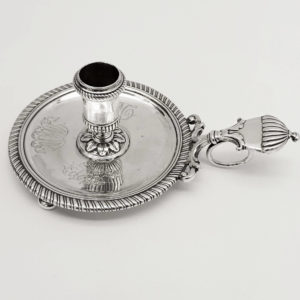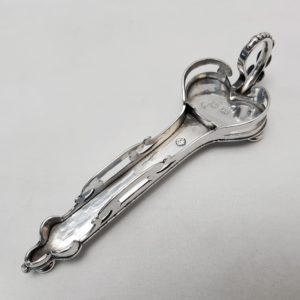Pierre Harache
Many members of the Harache family of goldsmiths, being of the Huguenot faith, came to London from France during the period 1667-1681 to avoid persecution. The family was active in the production of fine silver plate for about a hundred years and was responsible for some of England’s most important silversmithing of the time.
Pierre (Peter) Harache came to England in c.1680 and became free of the Goldsmiths Company in 1682. First mark (Sterling) in use in 1683. He took Simon Pantin as apprentice in 1686. Livery 1687. New Standard mark as largeworker, undated, probably 1697. Died c.1700.
Pierre Harache’s work is of the highest standard in both design and execution. He used cut card work and applied decoration as well as engraving. His fine craftsmanship is evident in the many pieces currently held in British collections such as:
Set of 4 candlesticks 1683 (Althorpe Abbey)
Cut card porringer 1695 (Ashmolean Museum)
Chocolate pot 1695 (formerly Noble collection)
Toilet Set 1695 (Marquess of Exeter)
Gold porringer and stand 1691 (Duke of Brunswick)
Important ewer and dish 1697 (British Museum)
Wine cistern of the Barber Surgeon’s Company
Pair of pilgrim bottles 1699 (Eton College)
Pierre Harache
Many members of the Harache family of goldsmiths, being of the Huguenot faith, came to London from France during the period 1667-1681 to avoid persecution. The family was active in the production of fine silver plate for about a hundred years and was responsible for some of England’s most important silversmithing of the time.
Pierre (Peter) Harache came to England in c.1680 and became free of the Goldsmiths Company in 1682. First mark (Sterling) in use in 1683. He took Simon Pantin as apprentice in 1686. Livery 1687. New Standard mark as largeworker, undated, probably 1697. Died c.1700.
Pierre Harache’s work is of the highest standard in both design and execution. He used cut card work and applied decoration as well as engraving. His fine craftsmanship is evident in the many pieces currently held in British collections such as:
Set of 4 candlesticks 1683 (Althorpe Abbey)
Cut card porringer 1695 (Ashmolean Museum)
Chocolate pot 1695 (formerly Noble collection)
Toilet Set 1695 (Marquess of Exeter)
Gold porringer and stand 1691 (Duke of Brunswick)
Important ewer and dish 1697 (British Museum)
Wine cistern of the Barber Surgeon’s Company
Pair of pilgrim bottles 1699 (Eton College)
-


1696
Pierre Harache
9567 William III Silver Chamberstick
Sold
A rare early English silver chamberstick (or “go to bed”) with the solid design and heavy gauge silver you’d expect from this date. Sterling silver. It has the early form with flat teardrop handle. The circular pan has a gadrooned border and ribbed sconce, all mounted on three small stump feet. Hand engraved to the centre are 3 ornamental cyphers. Weight 222 grams, 7.1 troy ounces. Diameter 10.8 cm, 4.25 inches. Length 17 cms. London 1696. Maker Pierre Harache.
-


1685
Pierre Harache
10204 James II Antique Silver Snuffer Tray
Sold
A very rare piece of 17th century silver from the highly sought after Huguenot maker Pierre Harache. This Jacobean silver snuffer tray is of triangular form with a pierced gallery to hold a pair wick trimmers (not supplied) snugly in place. Weight 802 grams, 25.7 troy ounces. Spread 17cm. Platform size 14 x 4.8cm. London 1685. Maker Pierre Harache. Sterling silver.